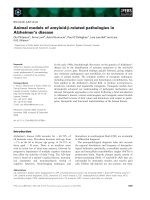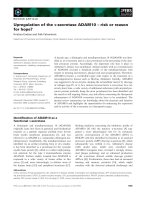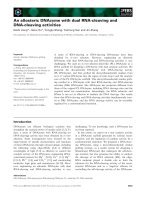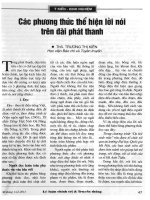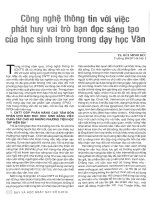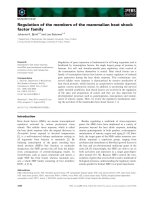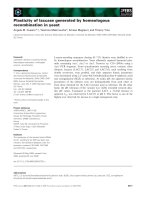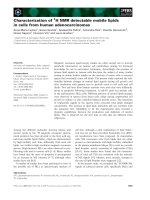Tài liệu Báo cáo khoa học: "Wikipedia as Sense Inventory to Improve Diversity in Web Search Results" doc
Bạn đang xem bản rút gọn của tài liệu. Xem và tải ngay bản đầy đủ của tài liệu tại đây (171.49 KB, 10 trang )
Proceedings of the 48th Annual Meeting of the Association for Computational Linguistics, pages 1357–1366,
Uppsala, Sweden, 11-16 July 2010.
c
2010 Association for Computational Linguistics
Wikipedia as Sense Inventory to Improve Diversity in Web Search Results
Celina Santamar
´
ıa, Julio Gonzalo and Javier Artiles
nlp.uned.es
UNED, c/Juan del Rosal, 16, 28040 Madrid, Spain
Abstract
Is it possible to use sense inventories to
improve Web search results diversity for
one word queries? To answer this ques-
tion, we focus on two broad-coverage lex-
ical resources of a different nature: Word-
Net, as a de-facto standard used in Word
Sense Disambiguation experiments; and
Wikipedia, as a large coverage, updated
encyclopaedic resource which may have a
better coverage of relevant senses in Web
pages.
Our results indicate that (i) Wikipedia has
a much better coverage of search results,
(ii) the distribution of senses in search re-
sults can be estimated using the internal
graph structure of the Wikipedia and the
relative number of visits received by each
sense in Wikipedia, and (iii) associating
Web pages to Wikipedia senses with sim-
ple and efficient algorithms, we can pro-
duce modified rankings that cover 70%
more Wikipedia senses than the original
search engine rankings.
1 Motivation
The application of Word Sense Disambiguation
(WSD) to Information Retrieval (IR) has been sub-
ject of a significant research effort in the recent
past. The essential idea is that, by indexing and
matching word senses (or even meanings) , the re-
trieval process could better handle polysemy and
synonymy problems (Sanderson, 2000). In prac-
tice, however, there are two main difficulties: (i)
for long queries, IR models implicitly perform
disambiguation, and thus there is little room for
improvement. This is the case with most stan-
dard IR benchmarks, such as TREC (trec.nist.gov)
or CLEF (www.clef-campaign.org) ad-hoc collec-
tions; (ii) for very short queries, disambiguation
may not be possible or even desirable. This is
often the case with one word and even two word
queries in Web search engines.
In Web search, there are at least three ways of
coping with ambiguity:
• Promoting diversity in the search results
(Clarke et al., 2008): given the query ”oa-
sis”, the search engine may try to include rep-
resentatives for different senses of the word
(such as the Oasis band, the Organization
for the Advancement of Structured Informa-
tion Standards, the online fashion store, etc.)
among the top results. Search engines are
supposed to handle diversity as one of the
multiple factors that influence the ranking.
• Presenting the results as a set of (labelled)
clusters rather than as a ranked list (Carpineto
et al., 2009).
• Complementing search results with search
suggestions (e.g. ”oasis band”, ”oasis fash-
ion store”) that serve to refine the query in the
intended way (Anick, 2003).
All of them rely on the ability of the search en-
gine to cluster search results, detecting topic simi-
larities. In all of them, disambiguation is implicit,
a side effect of the process but not its explicit tar-
get. Clustering may detect that documents about
the Oasis band and the Oasis fashion store deal
with unrelated topics, but it may as well detect
a group of documents discussing why one of the
Oasis band members is leaving the band, and an-
other group of documents about Oasis band lyrics;
both are different aspects of the broad topic Oa-
sis band. A perfect hierarchical clustering should
distinguish between the different Oasis senses at a
first level, and then discover different topics within
each of the senses.
Is it possible to use sense inventories to improve
search results for one word queries? To answer
1357
this question, we will focus on two broad-coverage
lexical resources of a different nature: WordNet
(Miller et al., 1990), as a de-facto standard used
in Word Sense Disambiguation experiments and
many other Natural Language Processing research
fields; and Wikipedia (www.wikipedia.org), as a
large coverage and updated encyclopedic resource
which may have a better coverage of relevant
senses in Web pages.
Our hypothesis is that, under appropriate con-
ditions, any of the above mechanisms (clustering,
search suggestions, diversity) might benefit from
an explicit disambiguation (classification of pages
in the top search results) using a wide-coverage
sense inventory. Our research is focused on four
relevant aspects of the problem:
1. Coverage: Are Wikipedia/Wordnet senses
representative of search results? Otherwise,
trying to make a disambiguation in terms of a
fixed sense inventory would be meaningless.
2. If the answer to (1) is positive, the reverse
question is also interesting: can we estimate
search results diversity using our sense inven-
tories?
3. Sense frequencies: knowing sense frequen-
cies in (search results) Web pages is crucial
to have a usable sense inventory. Is it possi-
ble to estimate Web sense frequencies from
currently available information?
4. Classification: The association of Web pages
to word senses must be done with some unsu-
pervised algorithm, because it is not possible
to hand-tag training material for every pos-
sible query word. Can this classification be
done accurately? Can it be effective to pro-
mote diversity in search results?
In order to provide an initial answer to these
questions, we have built a corpus consisting of 40
nouns and 100 Google search results per noun,
manually annotated with the most appropriate
Wordnet and Wikipedia senses. Section 2 de-
scribes how this corpus has been created, and in
Section 3 we discuss WordNet and Wikipedia cov-
erage of search results according to our testbed.
As this initial results clearly discard Wordnet as
a sense inventory for the task, the rest of the pa-
per mainly focuses on Wikipedia. In Section 4 we
estimate search results diversity from our testbed,
finding that the use of Wikipedia could substan-
tially improve diversity in the top results. In Sec-
tion 5 we use the Wikipedia internal link structure
and the number of visits per page to estimate rel-
ative frequencies for Wikipedia senses, obtaining
an estimation which is highly correlated with ac-
tual data in our testbed. Finally, in Section 6 we
discuss a few strategies to classify Web pages into
word senses, and apply the best classifier to en-
hance diversity in search results. The paper con-
cludes with a discussion of related work (Section
7) and an overall discussion of our results in Sec-
tion 8.
2 Test Set
2.1 Set of Words
The most crucial step in building our test set is
choosing the set of words to be considered. We
are looking for words which are susceptible to
form a one-word query for a Web search engine,
and therefore we should focus on nouns which
are used to denote one or more named entities.
At the same time we want to have some degree
of comparability with previous research on Word
Sense Disambiguation, which points to noun sets
used in Senseval/SemEval evaluation campaigns
1
.
Our budget for corpus annotation was enough for
two persons-month, which limited us to handle
40 nouns (usually enough to establish statistically
significant differences between WSD algorithms,
although obviously limited to reach solid figures
about the general behaviour of words in the Web).
With these arguments in mind, we decided to
choose: (i) 15 nouns from the Senseval-3 lexi-
cal sample dataset, which have been previously
employed by (Mihalcea, 2007) in a related ex-
periment (see Section 7); (ii) 25 additional words
which satisfy two conditions: they are all am-
biguous, and they are all names for music bands
in one of their senses (not necessarily the most
salient). The Senseval set is: {argument, arm,
atmosphere, bank, degree, difference, disc, im-
age, paper, party, performance, plan, shelter,
sort, source}. The bands set is {amazon, apple,
camel, cell, columbia, cream, foreigner, fox, gen-
esis, jaguar, oasis, pioneer, police, puma, rain-
bow, shell, skin, sun, tesla, thunder, total, traffic,
trapeze, triumph, yes}.
For each noun, we looked up all its possible
senses in WordNet 3.0 and in Wikipedia (using
1
1358
Table 1: Coverage of Search Results: Wikipedia vs. WordNet
Wikipedia WordNet
# senses # documents # senses # documents
available/used assigned to some sense available/used assigned to some sense
Senseval set 242/100 877 (59%) 92/52 696 (46%)
Bands set 640/174 1358 (54%) 78/39 599 (24%)
Total 882/274 2235 (56%) 170/91 1295 (32%)
Wikipedia disambiguation pages). Wikipedia has
an average of 22 senses per noun (25.2 in the
Bands set and 16.1 in the Senseval set), and Word-
net a much smaller figure, 4.5 (3.12 for the Bands
set and 6.13 for the Senseval set). For a conven-
tional dictionary, a higher ambiguity might indi-
cate an excess of granularity; for an encyclopaedic
resource such as Wikipedia, however, it is just
an indication of larger coverage. Wikipedia en-
tries for camel which are not in WordNet, for in-
stance, include the Apache Camel routing and me-
diation engine, the British rock band, the brand
of cigarettes, the river in Cornwall, and the World
World War I fighter biplane.
2.2 Set of Documents
We retrieved the 150 first ranked documents for
each noun, by submitting the nouns as queries to a
Web search engine (Google). Then, for each doc-
ument, we stored both the snippet (small descrip-
tion of the contents of retrieved document) and the
whole HTML document. This collection of docu-
ments contain an implicit new inventory of senses,
based on Web search, as documents retrieved by
a noun query are associated with some sense of
the noun. Given that every document in the top
Web search results is supposed to be highly rele-
vant for the query word, we assume a ”one sense
per document” scenario, although we allow an-
notators to assign more than one sense per doc-
ument. In general this assumption turned out to be
correct except in a few exceptional cases (such as
Wikipedia disambiguation pages): only nine docu-
ments received more than one WordNet sense, and
44 (1.1% of all annotated pages) received more
than one Wikipedia sense.
2.3 Manual Annotation
We implemented an annotation interface which
stored all documents and a short description for
every Wordnet and Wikipedia sense. The annota-
tors had to decide, for every document, whether
there was one or more appropriate senses in each
of the dictionaries. They were instructed to pro-
vide annotations for 100 documents per name; if
an URL in the list was corrupt or not available,
it had to be discarded. We provided 150 docu-
ments per name to ensure that the figure of 100 us-
able documents per name could be reached with-
out problems.
Each judge provided annotations for the 4,000
documents in the final data set. In a second round,
they met and discussed their independent annota-
tions together, reaching a consensus judgement for
every document.
3 Coverage of Web Search Results:
Wikipedia vs Wordnet
Table 1 shows how Wikipedia and Wordnet cover
the senses in search results. We report each noun
subset separately (Senseval and bands subsets) as
well as aggregated figures.
The most relevant fact is that, unsurprisingly,
Wikipedia senses cover much more search results
(56%) than Wordnet (32%). If we focus on the
top ten results, in the bands subset (which should
be more representative of plausible web queries)
Wikipedia covers 68% of the top ten documents.
This is an indication that it can indeed be useful
for promoting diversity or help clustering search
results: even if 32% of the top ten documents are
not covered by Wikipedia, it is still a representa-
tive source of senses in the top search results.
We have manually examined all documents
in the top ten results that are not covered by
Wikipedia: a majority of the missing senses con-
sists of names of (generally not well-known) com-
panies (45%) and products or services (26%); the
other frequent type (12%) of non annotated doc-
ument is disambiguation pages (from Wikipedia
and also from other dictionaries).
It is also interesting to examine the degree of
overlap between Wikipedia and Wordnet senses.
Being two different types of lexical resource,
they might have some degree of complementar-
ity. Table 2 shows, however, that this is not the
case: most of the (annotated) documents either fit
Wikipedia senses (26%) or both Wikipedia and
Wordnet (29%), and just 3% fit Wordnet only.
1359
Table 2: Overlap between Wikipedia and Wordnet in Search Results
# documents annotated with
Wikipedia & Wordnet Wikipedia only Wordnet only none
Senseval set 607 (40%) 270 (18%) 89 (6%) 534 (36%)
Bands set 572 (23%) 786 (31%) 27 (1%) 1115 (45%)
Total 1179 (29%) 1056 (26%) 116 (3%) 1649 (41%)
Therefore, Wikipedia seems to extend the cover-
age of Wordnet rather than providing complemen-
tary sense information. If we wanted to extend the
coverage of Wikipedia, the best strategy seems to
be to consider lists of companies, products and ser-
vices, rather than complementing Wikipedia with
additional sense inventories.
4 Diversity in Google Search Results
Once we know that Wikipedia senses are a rep-
resentative subset of actual Web senses (covering
more than half of the documents retrieved by the
search engine), we can test how well search results
respect diversity in terms of this subset of senses.
Table 3 displays the number of different senses
found at different depths in the search results rank,
and the average proportion of total senses that they
represent. These results suggest that diversity is
not a major priority for ranking results: the top
ten results only cover, in average, 3 Wikipedia
senses (while the average number of senses listed
in Wikipedia is 22). When considering the first
100 documents, this number grows up to 6.85
senses per noun.
Another relevant figure is the frequency of the
most frequent sense for each word: in average,
63% of the pages in search results belong to the
most frequent sense of the query word. This is
roughly comparable with most frequent sense fig-
ures in standard annotated corpora such as Sem-
cor (Miller et al., 1993) and the Senseval/Semeval
data sets, which suggests that diversity may not
play a major role in the current Google ranking al-
gorithm.
Of course this result must be taken with care,
because variability between words is high and un-
predictable, and we are using only 40 nouns for
our experiment. But what we have is a positive
indication that Wikipedia could be used to im-
prove diversity or cluster search results: poten-
tially the first top ten results could cover 6.15 dif-
ferent senses in average (see Section 6.5), which
would be a substantial growth.
5 Sense Frequency Estimators for
Wikipedia
Wikipedia disambiguation pages contain no sys-
tematic information about the relative importance
of senses for a given word. Such information,
however, is crucial in a lexicon, because sense dis-
tributions tend to be skewed, and knowing them
can help disambiguation algorithms.
We have attempted to use two estimators of ex-
pected sense distribution:
• Internal relevance of a word sense, measured
as incoming links for the URL of a given
sense in Wikipedia.
• External relevance of a word sense, measured
as the number of visits for the URL of a given
sense (as reported in ).
The number of internal incoming links is ex-
pected to be relatively stable for Wikipedia arti-
cles. As for the number of visits, we performed
a comparison of the number of visits received by
the bands noun subset in May, June and July 2009,
finding a stable-enough scenario with one notori-
ous exception: the number of visits to the noun
Tesla raised dramatically in July, because July 10
was the anniversary of the birth of Nicola Tesla,
and a special Google logo directed users to the
Wikipedia page for the scientist.
We have measured correlation between the rela-
tive frequencies derived from these two indicators
and the actual relative frequencies in our testbed.
Therefore, for each noun w and for each sense w
i
,
we consider three values: (i) proportion of doc-
uments retrieved for w which are manually as-
signed to each sense w
i
; (ii) inlinks(w
i
): rela-
tive amount of incoming links to each sense w
i
;
and (iii) visits(w
i
): relative number of visits to the
URL for each sense w
i
.
We have measured the correlation between
these three values using a linear regression corre-
lation coefficient, which gives a correlation value
of .54 for the number of visits and of .71 for the
number of incoming links. Both estimators seem
1360
Table 3: Diversity in Search Results according to Wikipedia
average # senses in search results average coverage of Wikipedia senses
Bands set Senseval set Total Bands set Senseval set Total
First 10 docs 2.88 3.2 3.00 .21 .21 .21
First 25 4.44 4.8 4.58 .28 .33 .30
First 50 5.56 5.47 5.53 .33 .36 .34
First 75 6.56 6.33 6.48 .37 .43 .39
First 100 6.96 6.67 6.85 .38 .45 .41
to be positively correlated with real relative fre-
quencies in our testbed, with a strong preference
for the number of links.
We have experimented with weighted combina-
tions of both indicators, using weights of the form
(k, 1 − k), k ∈ {0, 0.1, 0.2 . . . 1}, reaching a max-
imal correlation of .73 for the following weights:
freq(w
i
) = 0.9∗inlinks(w
i
)+0.1∗visits(w
i
) (1)
This weighted estimator provides a slight ad-
vantage over the use of incoming links only (.73
vs .71). Overall, we have an estimator which has
a strong correlation with the distribution of senses
in our testbed. In the next section we will test its
utility for disambiguation purposes.
6 Association of Wikipedia Senses to
Web Pages
We want to test whether the information provided
by Wikipedia can be used to classify search results
accurately. Note that we do not want to consider
approaches that involve a manual creation of train-
ing material, because they can’t be used in prac-
tice.
Given a Web page p returned by the search
engine for the query w, and the set of senses
w
1
. . . w
n
listed in Wikipedia, the task is to assign
the best candidate sense to p. We consider two
different techniques:
• A basic Information Retrieval approach,
where the documents and the Wikipedia
pages are represented using a Vector Space
Model (VSM) and compared with a standard
cosine measure. This is a basic approach
which, if successful, can be used efficiently
to classify search results.
• An approach based on a state-of-the-art su-
pervised WSD system, extracting training ex-
amples automatically from Wikipedia con-
tent.
We also compute two baselines:
• A random assignment of senses (precision is
computed as the inverse of the number of
senses, for every test case).
• A most frequent sense heuristic which uses
our estimation of sense frequencies and as-
signs the same sense (the most frequent) to
all documents.
Both are naive baselines, but it must be noted
that the most frequent sense heuristic is usually
hard to beat for unsupervised WSD algorithms in
most standard data sets.
We now describe each of the two main ap-
proaches in detail.
6.1 VSM Approach
For each word sense, we represent its Wikipedia
page in a (unigram) vector space model, assigning
standard tf*idf weights to the words in the docu-
ment. idf weights are computed in two different
ways:
1. Experiment VSM computes inverse docu-
ment frequencies in the collection of re-
trieved documents (for the word being con-
sidered).
2. Experiment VSM-GT uses the statistics pro-
vided by the Google Terabyte collection
(Brants and Franz, 2006), i.e. it replaces the
collection of documents with statistics from a
representative snapshot of the Web.
3. Experiment VSM-mixed combines statistics
from the collection and from the Google
Terabyte collection, following (Chen et al.,
2009).
The document p is represented in the same vec-
tor space as the Wikipedia senses, and it is com-
pared with each of the candidate senses w
i
via the
cosine similarity metric (we have experimented
1361
with other similarity metrics such as χ
2
, but dif-
ferences are irrelevant). The sense with the high-
est similarity to p is assigned to the document. In
case of ties (which are rare), we pick the first sense
in the Wikipedia disambiguation page (which in
practice is like a random decision, because senses
in disambiguation pages do not seem to be ordered
according to any clear criteria).
We have also tested a variant of this approach
which uses the estimation of sense frequencies
presented above: once the similarities are com-
puted, we consider those cases where two or more
senses have a similar score (in particular, all senses
with a score greater or equal than 80% of the high-
est score). In that cases, instead of using the small
similarity differences to select a sense, we pick up
the one which has the largest frequency according
to our estimator. We have applied this strategy to
the best performing system, VSM-GT, resulting in
experiment VSM-GT+freq.
6.2 WSD Approach
We have used TiMBL (Daelemans et al., 2001),
a state-of-the-art supervised WSD system which
uses Memory-Based Learning. The key, in this
case, is how to extract learning examples from the
Wikipedia automatically. For each word sense, we
basically have three sources of examples: (i) oc-
currences of the word in the Wikipedia page for
the word sense; (ii) occurrences of the word in
Wikipedia pages pointing to the page for the word
sense; (iii) occurrences of the word in external
pages linked in the Wikipedia page for the word
sense.
After an initial manual inspection, we decided
to discard external pages for being too noisy, and
we focused on the first two options. We tried three
alternatives:
• TiMBL-core uses only the examples found
in the page for the sense being trained.
• TiMBL-inlinks uses the examples found in
Wikipedia pages pointing to the sense being
trained.
• TiMBL-all uses both sources of examples.
In order to classify a page p with respect to the
senses for a word w, we first disambiguate all oc-
currences of w in the page p. Then we choose the
sense which appears most frequently in the page
according to TiMBL results. In case of ties we
pick up the first sense listed in the Wikipedia dis-
ambiguation page.
We have also experimented with a variant of
the approach that uses our estimation of sense fre-
quencies, similarly to what we did with the VSM
approach. In this case, (i) when there is a tie be-
tween two or more senses (which is much more
likely than in the VSM approach), we pick up the
sense with the highest frequency according to our
estimator; and (ii) when no sense reaches 30% of
the cases in the page to be disambiguated, we also
resort to the most frequent sense heuristic (among
the candidates for the page). This experiment is
called TiMBL-core+freq (we discarded ”inlinks”
and ”all” versions because they were clearly worse
than ”core”).
6.3 Classification Results
Table 4 shows classification results. The accuracy
of systems is reported as precision, i.e. the number
of pages correctly classified divided by the total
number of predictions. This is approximately the
same as recall (correctly classified pages divided
by total number of pages) for our systems, because
the algorithms provide an answer for every page
containing text (actual coverage is 94% because
some pages only contain text as part of an image
file such as photographs and logotypes).
Table 4: Classification Results
Experiment Precision
random .19
most frequent sense (estimation) .46
TiMBL-core .60
TiMBL-inlinks .50
TiMBL-all .58
TiMBL-core+freq .67
VSM .67
VSM-GT .68
VSM-mixed .67
VSM-GT+freq .69
All systems are significantly better than the
random and most frequent sense baselines (using
p < 0.05 for a standard t-test). Overall, both ap-
proaches (using TiMBL WSD machinery and us-
ing VSM) lead to similar results (.67 vs. .69),
which would make VSM preferable because it is
a simpler and more efficient approach. Taking a
1362
Figure 1: Precision/Coverage curves for VSM-GT+freq classification algorithm
closer look at the results with TiMBL, there are a
couple of interesting facts:
• There is a substantial difference between us-
ing only examples taken from the Wikipedia
Web page for the sense being trained
(TiMBL-core, .60) and using examples from
the Wikipedia pages pointing to that page
(TiMBL-inlinks, .50). Examples taken from
related pages (even if the relationship is close
as in this case) seem to be too noisy for the
task. This result is compatible with findings
in (Santamar
´
ıa et al., 2003) using the Open
Directory Project to extract examples auto-
matically.
• Our estimation of sense frequencies turns
out to be very helpful for cases where our
TiMBL-based algorithm cannot provide an
answer: precision rises from .60 (TiMBL-
core) to .67 (TiMBL-core+freq). The differ-
ence is statistically significant (p < 0.05) ac-
cording to the t-test.
As for the experiments with VSM, the varia-
tions tested do not provide substantial improve-
ments to the baseline (which is .67). Using idf fre-
quencies obtained from the Google Terabyte cor-
pus (instead of frequencies obtained from the set
of retrieved documents) provides only a small im-
provement (VSM-GT, .68), and adding the esti-
mation of sense frequencies gives another small
improvement (.69). Comparing the baseline VSM
with the optimal setting (VSM-GT+freq), the dif-
ference is small (.67 vs .69) but relatively robust
(p = 0.066 according to the t-test).
Remarkably, the use of frequency estimations
is very helpful for the WSD approach but not for
the SVM one, and they both end up with similar
performance figures; this might indicate that using
frequency estimations is only helpful up to certain
precision ceiling.
6.4 Precision/Coverage Trade-off
All the above experiments are done at maximal
coverage, i.e., all systems assign a sense for every
document in the test collection (at least for every
document with textual content). But it is possible
to enhance search results diversity without anno-
tating every document (in fact, not every document
can be assigned to a Wikipedia sense, as we have
discussed in Section 3). Thus, it is useful to inves-
tigate which is the precision/coverage trade-off in
our dataset. We have experimented with the best
performing system (VSM-GT+freq), introducing
a similarity threshold: assignment of a document
to a sense is only done if the similarity of the doc-
ument to the Wikipedia page for the sense exceeds
the similarity threshold.
We have computed precision and coverage for
every threshold in the range [0.00 − 0.90] (beyond
0.90 coverage was null) and represented the results
in Figure 1 (solid line). The graph shows that we
1363
can classify around 20% of the documents with a
precision above .90, and around 60% of the docu-
ments with a precision of .80.
Note that we are reporting disambiguation re-
sults using a conventional WSD test set, i.e., one
in which every test case (every document) has
been manually assigned to some Wikipedia sense.
But in our Web Search scenario, 44% of the
documents were not assigned to any Wikipedia
sense: in practice, our classification algorithm
would have to cope with all this noise as well.
Figure 1 (dotted line) shows how the preci-
sion/coverage curve is affected when the algo-
rithm attempts to disambiguate all documents re-
trieved by Google, whether they can in fact be as-
signed to a Wikipedia sense or not. At a coverage
of 20%, precision drops approximately from .90 to
.70, and at a coverage of 60% it drops from .80 to
.50. We now address the question of whether this
performance is good enough to improve search re-
sults diversity in practice.
6.5 Using Classification to Promote Diversity
We now want to estimate how the reported clas-
sification accuracy may perform in practice to en-
hance diversity in search results. In order to pro-
vide an initial answer to this question, we have
re-ranked the documents for the 40 nouns in our
testbed, using our best classifier (VSM-GT+freq)
and making a list of the top-ten documents with
the primary criterion of maximising the number
of senses represented in the set, and the secondary
criterion of maximising the similarity scores of the
documents to their assigned senses. The algorithm
proceeds as follows: we fill each position in the
rank (starting at rank 1), with the document which
has the highest similarity to some of the senses
which are not yet represented in the rank; once all
senses are represented, we start choosing a second
representative for each sense, following the same
criterion. The process goes on until the first ten
documents are selected.
We have also produced a number of alternative
rankings for comparison purposes:
• clustering (centroids): this method ap-
plies Hierarchical Agglomerative Clustering
– which proved to be the most competitive
clustering algorithm in a similar task (Artiles
et al., 2009) – to the set of search results,
forcing the algorithm to create ten clusters.
The centroid of each cluster is then selected
Table 5: Enhancement of Search Results Diversity
rank@10 # senses coverage
Original rank 2.80 49%
Wikipedia 4.75 77%
clustering (centroids) 2.50 42%
clustering (top ranked) 2.80 46%
random 2.45 43%
upper bound 6.15 97%
as one of the top ten documents in the new
rank.
• clustering (top ranked): Applies the same
clustering algorithm, but this time the top
ranked document (in the original Google
rank) of each cluster is selected.
• random: Randomly selects ten documents
from the set of retrieved results.
• upper bound: This is the maximal diversity
that can be obtained in our testbed. Note that
coverage is not 100%, because some words
have more than ten meanings in Wikipedia
and we are only considering the top ten doc-
uments.
All experiments have been applied on the full
set of documents in the testbed, including those
which could not be annotated with any Wikipedia
sense. Coverage is computed as the ratio of senses
that appear in the top ten results compared to the
number of senses that appear in all search results.
Results are presented in Table 5. Note that di-
versity in the top ten documents increases from
an average of 2.80 Wikipedia senses represented
in the original search engine rank, to 4.75 in the
modified rank (being 6.15 the upper bound), with
the coverage of senses going from 49% to 77%.
With a simple VSM algorithm, the coverage of
Wikipedia senses in the top ten results is 70%
larger than in the original ranking.
Using Wikipedia to enhance diversity seems to
work much better than clustering: both strategies
to select a representative from each cluster are un-
able to improve the diversity of the original rank-
ing. Note, however, that our evaluation has a bias
towards using Wikipedia, because only Wikipedia
senses are considered to estimate diversity.
Of course our results do not imply that the
Wikipedia modified rank is better than the original
1364
Google rank: there are many other factors that in-
fluence the final ranking provided by a search en-
gine. What our results indicate is that, with simple
and efficient algorithms, Wikipedia can be used as
a reference to improve search results diversity for
one-word queries.
7 Related Work
Web search results clustering and diversity in
search results are topics that receive an increas-
ing attention from the research community. Diver-
sity is used both to represent sub-themes in a broad
topic, or to consider alternative interpretations for
ambiguous queries (Agrawal et al., 2009), which
is our interest here. Standard IR test collections do
not usually consider ambiguous queries, and are
thus inappropriate to test systems that promote di-
versity (Sanderson, 2008); it is only recently that
appropriate test collections are being built, such as
(Paramita et al., 2009) for image search and (Ar-
tiles et al., 2009) for person name search. We see
our testbed as complementary to these ones, and
expect that it can contribute to foster research on
search results diversity.
To our knowledge, Wikipedia has not explicitly
been used before to promote diversity in search
results; but in (Gollapudi and Sharma, 2009), it
is used as a gold standard to evaluate diversifica-
tion algorithms: given a query with a Wikipedia
disambiguation page, an algorithm is evaluated as
promoting diversity when different documents in
the search results are semantically similar to dif-
ferent Wikipedia pages (describing the alternative
senses of the query). Although semantic similarity
is measured automatically in this work, our results
confirm that this evaluation strategy is sound, be-
cause Wikipedia senses are indeed representative
of search results.
(Clough et al., 2009) analyses query diversity in
a Microsoft Live Search, using click entropy and
query reformulation as diversity indicators. It was
found that at least 9.5% - 16.2% of queries could
benefit from diversification, although no correla-
tion was found between the number of senses of a
word in Wikipedia and the indicators used to dis-
cover diverse queries. This result does not discard,
however, that queries where applying diversity is
useful cannot benefit from Wikipedia as a sense
inventory.
In the context of clustering, (Carmel et al.,
2009) successfully employ Wikipedia to enhance
automatic cluster labeling, finding that Wikipedia
labels agree with manual labels associated by hu-
mans to a cluster, much more than with signif-
icant terms that are extracted directly from the
text. In a similar line, both (Gabrilovich and
Markovitch, 2007) and (Syed et al., 2008) provide
evidence suggesting that categories of Wikipedia
articles can successfully describe common con-
cepts in documents.
In the field of Natural Language Processing,
there has been successful attempts to connect
Wikipedia entries to Wordnet senses: (Ruiz-
Casado et al., 2005) reports an algorithm that
provides an accuracy of 84%. (Mihalcea, 2007)
uses internal Wikipedia hyperlinks to derive sense-
tagged examples. But instead of using Wikipedia
directly as sense inventory, Mihalcea then manu-
ally maps Wikipedia senses into Wordnet senses
(claiming that, at the time of writing the paper,
Wikipedia did not consistently report ambiguity
in disambiguation pages) and shows that a WSD
system based on acquired sense-tagged examples
reaches an accuracy well beyond an (informed)
most frequent sense heuristic.
8 Conclusions
We have investigated whether generic lexical re-
sources can be used to promote diversity in Web
search results for one-word, ambiguous queries.
We have compared WordNet and Wikipedia and
arrived to a number of conclusions: (i) unsurpris-
ingly, Wikipedia has a much better coverage of
senses in search results, and is therefore more ap-
propriate for the task; (ii) the distribution of senses
in search results can be estimated using the in-
ternal graph structure of the Wikipedia and the
relative number of visits received by each sense
in Wikipedia, and (iii) associating Web pages to
Wikipedia senses with simple and efficient algo-
rithms, we can produce modified rankings that
cover 70% more Wikipedia senses than the orig-
inal search engine rankings.
We expect that the testbed created for this re-
search will complement the - currently short - set
of benchmarking test sets to explore search re-
sults diversity and query ambiguity. Our testbed
is publicly available for research purposes at
.
Our results endorse further investigation on the
use of Wikipedia to organize search results. Some
limitations of our research, however, must be
1365
noted: (i) the nature of our testbed (with every
search result manually annotated in terms of two
sense inventories) makes it too small to extract
solid conclusions on Web searches (ii) our work
does not involve any study of diversity from the
point of view of Web users (i.e. when a Web
query addresses many different use needs in prac-
tice); research in (Clough et al., 2009) suggests
that word ambiguity in Wikipedia might not be re-
lated with diversity of search needs; (iii) we have
tested our classifiers with a simple re-ordering of
search results to test how much diversity can be
improved, but a search results ranking depends on
many other factors, some of them more crucial
than diversity; it remains to be tested how can we
use document/Wikipedia associations to improve
search results clustering (for instance, providing
seeds for the clustering process) and to provide
search suggestions.
Acknowledgments
This work has been partially funded by the Span-
ish Government (project INES/Text-Mess) and the
Xunta de Galicia.
References
R. Agrawal, S. Gollapudi, A. Halverson, and S. Leong.
2009. Diversifying Search Results. In Proc. of
WSDM’09. ACM.
P. Anick. 2003. Using Terminological Feedback for
Web Search Refinement : a Log-based Study. In
Proc. ACM SIGIR 2003, pages 88–95. ACM New
York, NY, USA.
J. Artiles, J. Gonzalo, and S. Sekine. 2009. WePS
2 Evaluation Campaign: overview of the Web Peo-
ple Search Clustering Task. In 2nd Web People
Search Evaluation Workshop (WePS 2009), 18th
WWW Conference. 2009.
T. Brants and A. Franz. 2006. Web 1T 5-gram, version
1. Philadelphia: Linguistic Data Consortium.
D. Carmel, H. Roitman, and N. Zwerdling. 2009. En-
hancing Cluster Labeling using Wikipedia. In Pro-
ceedings of the 32nd international ACM SIGIR con-
ference on Research and development in information
retrieval, pages 139–146. ACM.
C. Carpineto, S. Osinski, G. Romano, and Dawid
Weiss. 2009. A Survey of Web Clustering Engines.
ACM Computing Surveys, 41(3).
Y. Chen, S. Yat Mei Lee, and C. Huang. 2009.
PolyUHK: A Robust Information Extraction System
for Web Personal Names. In Proc. WWW’09 (WePS-
2 Workshop). ACM.
C. Clarke, M. Kolla, G. Cormack, O. Vechtomova,
A. Ashkan, S. B
¨
uttcher, and I. MacKinnon. 2008.
Novelty and Diversity in Information Retrieval Eval-
uation. In Proc. SIGIR’08, pages 659–666. ACM.
P. Clough, M. Sanderson, M. Abouammoh, S. Navarro,
and M. Paramita. 2009. Multiple Approaches to
Analysing Query Diversity. In Proc. of SIGIR 2009.
ACM.
W. Daelemans, J. Zavrel, K. van der Sloot, and
A. van den Bosch. 2001. TiMBL: Tilburg Memory
Based Learner, version 4.0, Reference Guide. Tech-
nical report, University of Antwerp.
E. Gabrilovich and S. Markovitch. 2007. Computing
Semantic Relatedness using Wikipedia-based Ex-
plicit Semantic Analysis. In Proceedings of The
20th International Joint Conference on Artificial In-
telligence (IJCAI), Hyderabad, India.
S. Gollapudi and A. Sharma. 2009. An Axiomatic Ap-
proach for Result Diversification. In Proc. WWW
2009, pages 381–390. ACM New York, NY, USA.
R. Mihalcea. 2007. Using Wikipedia for Automatic
Word Sense Disambiguation. In Proceedings of
NAACL HLT, volume 2007.
G. Miller, C. R. Beckwith, D. Fellbaum, Gross, and
K. Miller. 1990. Wordnet: An on-line lexical
database. International Journal of Lexicograph,
3(4).
G.A Miller, C. Leacock, R. Tengi, and Bunker R. T.
1993. A Semantic Concordance. In Proceedings of
the ARPA WorkShop on Human Language Technol-
ogy. San Francisco, Morgan Kaufman.
M. Paramita, M. Sanderson, and P. Clough. 2009. Di-
versity in Photo Retrieval: Overview of the Image-
CLEFPhoto task 2009. CLEF working notes, 2009.
M. Ruiz-Casado, E. Alfonseca, and P. Castells. 2005.
Automatic Assignment of Wikipedia Encyclopaedic
Entries to Wordnet Synsets. Advances in Web Intel-
ligence, 3528:380–386.
M. Sanderson. 2000. Retrieving with Good Sense. In-
formation Retrieval, 2(1):49–69.
M. Sanderson. 2008. Ambiguous Queries: Test Col-
lections Need More Sense. In Proceedings of the
31st annual international ACM SIGIR conference on
Research and development in information retrieval,
pages 499–506. ACM New York, NY, USA.
C. Santamar
´
ıa, J. Gonzalo, and F. Verdejo. 2003.
Automatic Association of Web Directories to Word
Senses. Computational Linguistics, 29(3):485–502.
Z. S. Syed, T. Finin, and Joshi. A. 2008. Wikipedia
as an Ontology for Describing Documents. In Proc.
ICWSM’08.
1366

